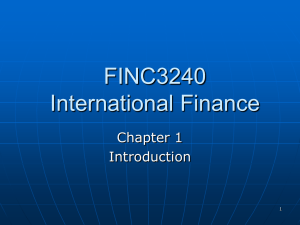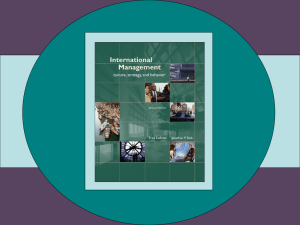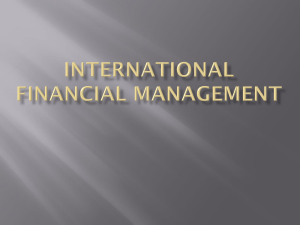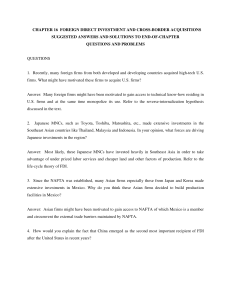File
advertisement
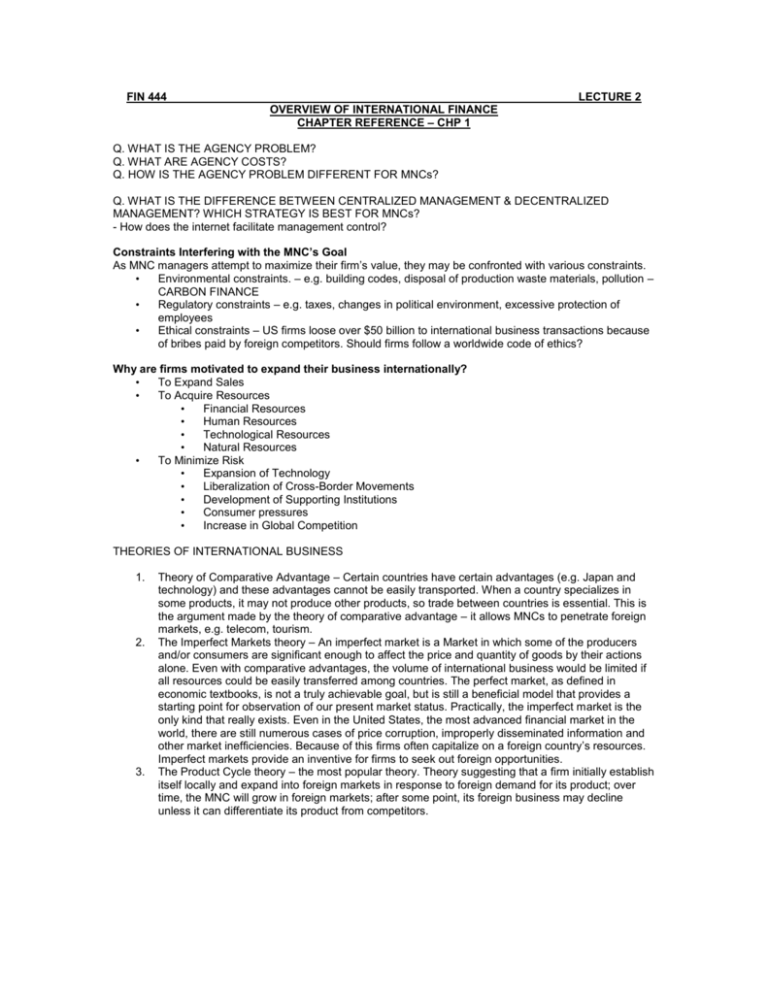
FIN 444 LECTURE 2 OVERVIEW OF INTERNATIONAL FINANCE CHAPTER REFERENCE – CHP 1 Q. WHAT IS THE AGENCY PROBLEM? Q. WHAT ARE AGENCY COSTS? Q. HOW IS THE AGENCY PROBLEM DIFFERENT FOR MNCs? Q. WHAT IS THE DIFFERENCE BETWEEN CENTRALIZED MANAGEMENT & DECENTRALIZED MANAGEMENT? WHICH STRATEGY IS BEST FOR MNCs? - How does the internet facilitate management control? Constraints Interfering with the MNC’s Goal As MNC managers attempt to maximize their firm’s value, they may be confronted with various constraints. • Environmental constraints. – e.g. building codes, disposal of production waste materials, pollution – CARBON FINANCE • Regulatory constraints – e.g. taxes, changes in political environment, excessive protection of employees • Ethical constraints – US firms loose over $50 billion to international business transactions because of bribes paid by foreign competitors. Should firms follow a worldwide code of ethics? Why are firms motivated to expand their business internationally? • To Expand Sales • To Acquire Resources • Financial Resources • Human Resources • Technological Resources • Natural Resources • To Minimize Risk • Expansion of Technology • Liberalization of Cross-Border Movements • Development of Supporting Institutions • Consumer pressures • Increase in Global Competition THEORIES OF INTERNATIONAL BUSINESS 1. 2. 3. Theory of Comparative Advantage – Certain countries have certain advantages (e.g. Japan and technology) and these advantages cannot be easily transported. When a country specializes in some products, it may not produce other products, so trade between countries is essential. This is the argument made by the theory of comparative advantage – it allows MNCs to penetrate foreign markets, e.g. telecom, tourism. The Imperfect Markets theory – An imperfect market is a Market in which some of the producers and/or consumers are significant enough to affect the price and quantity of goods by their actions alone. Even with comparative advantages, the volume of international business would be limited if all resources could be easily transferred among countries. The perfect market, as defined in economic textbooks, is not a truly achievable goal, but is still a beneficial model that provides a starting point for observation of our present market status. Practically, the imperfect market is the only kind that really exists. Even in the United States, the most advanced financial market in the world, there are still numerous cases of price corruption, improperly disseminated information and other market inefficiencies. Because of this firms often capitalize on a foreign country’s resources. Imperfect markets provide an inventive for firms to seek out foreign opportunities. The Product Cycle theory – the most popular theory. Theory suggesting that a firm initially establish itself locally and expand into foreign markets in response to foreign demand for its product; over time, the MNC will grow in foreign markets; after some point, its foreign business may decline unless it can differentiate its product from competitors. INTERNATIONAL BUSINESS METHODS MNCs use several methods to conduct international business. INTERNATIONAL TRADE – Relatively conservative approach that can be used by MNCs to penetrate markets by exporting or to obtain supplies at a low cost by importing. This approach entails minimal risk because the firm does not place any of its capital at significant risk. Most MNCs generate income through sales from exporting. - Internet and international trade. LISCENSING – Obligates a firm to provide its technology (copyrights, patents, trademarks etc.) in exchange for fees or some other specified benefits. E.g. AT&T and Verizon Communications have licensing agreements to build and operate parts of India’s telephone system, COSTCO. Licensing allows firms to use their technology in foreign markets without a major investment in foreign countries and without the transportation costs that result from exporting. Disadvantage – quality control in foreign production process. FRANCHISING – obligates a firm to provide a specialized sales or service strategy, support assistance, and possibly an initial investment in the franchise in exchange for periodic fees. E.g. KFC, PIZZA HUT etc. Franchising allows firms to penetrate foreign markets without a major investment in foreign countries. JOINT VENTURE – jointly owned and operated by two of more firms. Examples? ACQUISITIONS OF EXISTING OPERATIONS – subject to the risk of large losses, because of the large investment required. Some firms engage in partial international acquisitions in order to obtain a stake in foreign operations. This requires a smaller investment than full international acquisitions and therefore exposes the firm to less risk. Disadvantage – less control. ESTABLISHING NEW FOREIGN SUBSIDIARIES – Involves a large investment. Smaller investment may be required than would be needed to purchase existing operations. However the firm will not reap any rewards from the investment until the subsidiary isbui8lt and a customer base established. SUMMARY OF METHODS – DFI Any method of increasing international business that requires a direct investment in foreign operations normally is referred to as a DIRECT FOREIGN INVESTMENT. International trade and licensing usually are not considered to be DFI because they do not involve direct invest in foreign operations. Franchising and joint ventures tend to require some investment in foreign operations, but a limited degree. Foreign acquisitions and the establishment of new foreign subsidiaries require substantial investment in foreign operations and represent the largest portion of DFI. WHICH METHOD IS BEST FOR BANGLADESH?
